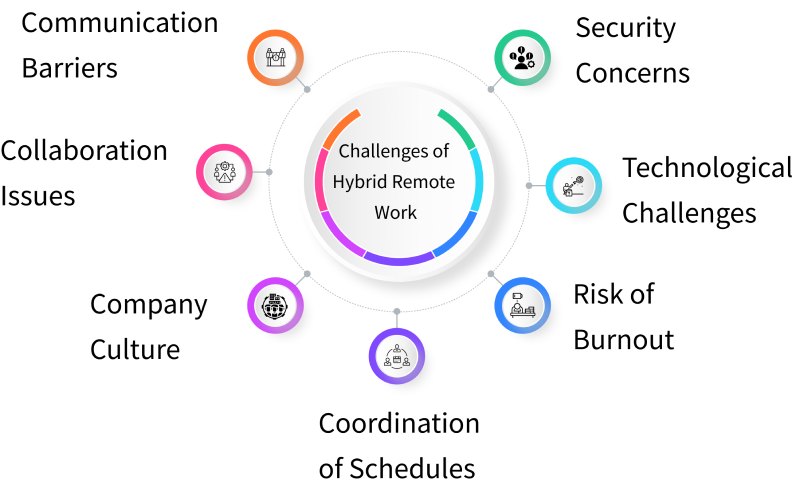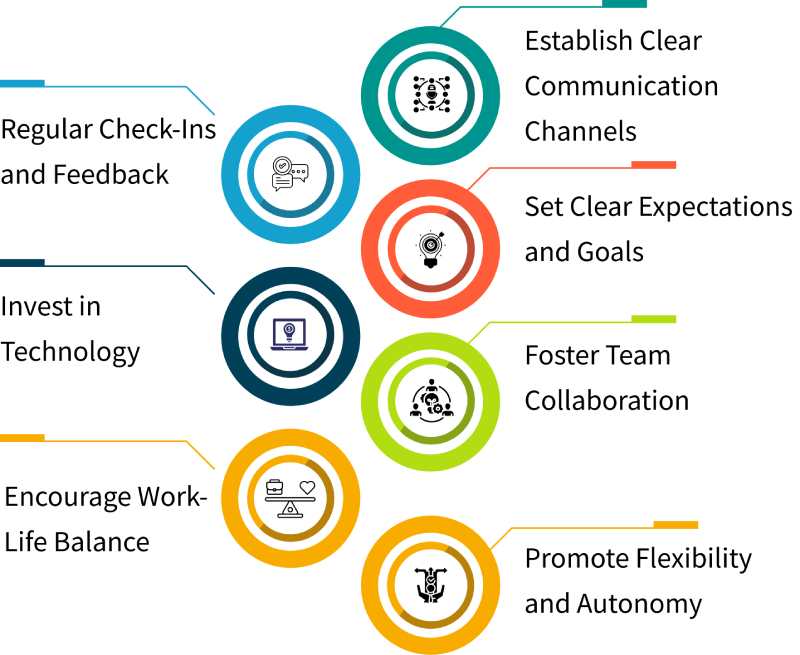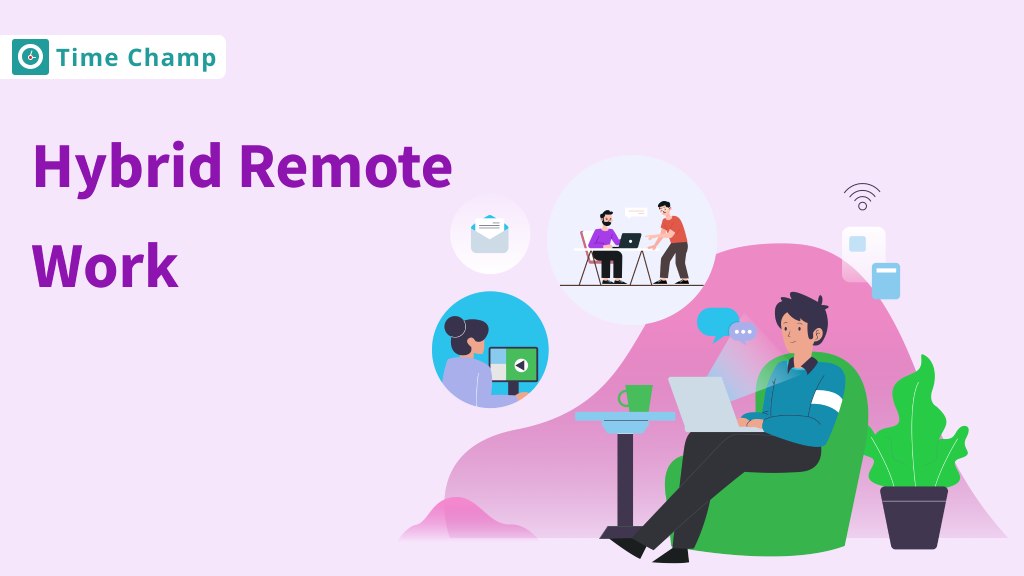Managing workforces has become increasingly challenging as companies struggle to balance employee flexibility with productivity. A hybrid remote work is a flexible work model that is a combination of remote and in-office work. Employees can work from the office on some days and from home on other days. For example, an employee may be at home three days a week and at the office two days a week.
In this guide, we will explore how hybrid remote work transforms your workplace into a more balanced, efficient environment. Let’s dive in!
Benefits of Hybrid Remote Work
According to a Gallup report, 55% of remotely capable employees expect to work hybrid in the future. And 25% of remote capable employees plan to work exclusively remotely in the future. Let’s explore the benefits of hybrid work for both employees and employers:

1. Improves Employee Flexibility
In hybrid remote work, your employees can work from anywhere and however they want, which results in a better work-life balance. There is less rigid schedule for the employees and more freedom to schedule their time as per that employee’s own personal commitments and professional commitments too.
They are flexible so that they can work when they are most productive early in the morning or later in the day, which often in turn equates to better focus and more output. Such a level of adaptability allows employees to stay engaged and motivated.
2. Enhances Productivity
Finding the right balance between different work environments can make employees work easier and more productive. Employees can work better and faster when they are less distracted. This model helps them stay organized and accomplish more.
When employees are in the same location it is easy for them to share ideas and solve problems as a team. It makes everyone feel more effective and get more done, and it also means that people are more productive when they are working together.
3. Better Employee Work-Life Balance
Hybrid remote work allows employees to plan their day to balance their work and activities they enjoy. They get time to spend with their family or hobbies. It’s flexibility, which is different than traditional office hours, and allows employees more freedom to manage their day.
A better work-life balance leads to less stress and better employee well-being. Employees are happier and more likely to stay with their current job if they feel in control of their time. They get some control over what is going on, without feeling overwhelmed, which makes for a more pleasant work experience.
4. Improves Trust
Hybrid work is only successful if you can trust your employees. When you allow your employees to work wherever and however, they want, it means you trust your employees to do their jobs well. A positive relationship between employees and management is created by trust.
Employees are happier and more committed to their organization when they feel they are being trusted. They are more engaged and more eager to work towards the company’s goals. It makes the workplace better for everyone.
5. Cost Savings
Hybrid work can save you and your employees money. You can save on office space, utilities, and supplies. The extra funds are used to invest in new technology and train your teams. Employees also spend less on commuting, meals, and work clothes.
This setup keeps more of their earnings and makes them feel satisfied at work. It supports your company’s growth at the same time that it offers employees financial freedom and happiness in their roles.
Challenges of Hybrid Remote Work
The hybrid remote model allows more flexibility in the workplace. Employees enjoy the flexibility of working from home and the office. In both environments, employers need to maintain productivity and security. Let’s look at some of the major challenges that come with working in a hybrid environment:

1. Communication Barriers
Communication is one of the main challenges in the hybrid remote work model. It can be difficult for you to keep everyone updated when some of your employees are in the office and some are at home. Sometimes when teams rely on emails and messaging apps more than direct conversations, things can get confusing.
It also delays the decision-making process and makes everyone frustrated. Maintaining team connectivity requires effective and transparent communication.
2. Collaboration Issues
Hybrid work settings can make collaboration a challenge. And when team members aren’t physically present for discussions or brainstorming sessions, those sessions can feel a bit disconnected.
This makes it hard for you and your employees to share ideas and give quick feedback. During virtual meetings, you may have a hard time keeping everyone engaged, and employees may feel isolated.
3. Company Culture
It’s difficult to establish an efficient work environment in a hybrid setting. If you are an employer, you might be worried about team unity. Employees might have a struggle to connect with the company’s values and mission.
Building a strong hybrid company culture isn’t easy. Keeping employees motivated is crucial, and it’s important to keep them engaged.
3. Coordination of Schedules
A hybrid workplace can be tricky to coordinate schedules. Scheduling meetings when employees work at different times and different locations can be difficult. It’s often a challenge to find common times.
It can stop workflows, miss deadlines, and cause stress for you and your team. Time management is good, but it’s hard to get everyone’s calendars to sync.
4. Risk of Burnout
Remote work in general increases the risk of burnout, and hybrid remote work increases the risk even further. Many employees who work from home and the office on an alternate schedule mix their personal and work lives. This blending then can result in longer hours and more stress, making it hard for them to shut out work.
In an atmosphere of employees juggling multiple responsibilities, the feeling of being overwhelmed can lead to reduced productivity. Organizations must acknowledge and resolve those challenges to promote a good work-life balance and prevent burnout.
5. Technological Challenges
Hybrid work requires technology, but it can also have problems with technology. Issues such as slow internet, software that doesn’t work well together, or learning new tools may be causing struggles for you and your team.
These issues may affect productivity and be frustrating. Everyone must have the technology and the support to be sure things keep running smoothly.
6. Security Concerns
Security is very important in hybrid work arrangements. The risk is when team members working at different locations access sensitive information. Both employers and employees need security measures to protect company data.
This may cause anxiety and one needs to be trained and aware very often. In this changing work environment, ensuring security practices are up to date is critical to the protection of sensitive information.
Tips to Manage Hybrid Remote Team Successfully
It’s not easy to manage a hybrid remote team, but there are ways to make it happen and keep your team productive and cohesive. Here are some tips to manage your hybrid team effectively:

Establish Clear Communication Channels
Managing a hybrid remote team is all about effective communication. To keep everyone connected, offer Slack or Microsoft Teams as a quick messaging tool and Zoom or Google Meet for video meetings. Ensure that your team knows when to use each platform.
Be clear on how and when to communicate. For example, assigning one channel for issues and another for daily project status or check-ins. It helps reduce confusion and makes communication more organized. Set communication guidelines that encourage transparency for all remote and in-office employees, ensuring alignment despite hybrid work schedules.
Regular chats, emails, or even brief meetings, keep people up to speed with what’s going on and nobody feels like they are missing out. Use asynchronous communication to work with different time zones and working hours. If everyone knows where to go to have certain conversations, your team can stay on track and be more productive overall.
Set Clear Expectations and Goals
Being able to assign tasks and give ownership to employees with precision means that everyone understands their expectations. Describe how you break down tasks into clear deliverables and what outcome you want to see come forth.
The SMART framework (Specific, Measurable, Attainable, Relevant, Time-bound) will help you create actionable goals that will keep everyone on track. If the expectations are simple, employees can work on their time, and stay on track to meet their deadlines.
In addition, it’s also important to check on these goals periodically and make adjustments as necessary. During these reviews give constructive feedback to keep the motivation high and fix any roadblocks. If you have clear goals and consistent follow-ups, you can drive performance and keep your hybrid team on track.
Foster Team Collaboration
Let your team work together effortlessly, even if they are remote. You can use collaborative tools like Time Champ, Trello, or Asana to manage projects, assign tasks, check progress, and work with your team. These platforms keep everyone on the same page and contribute to projects together.
Promoting open discussions and brainstorming sessions creates opportunities for a functional collaboration, that also fosters a sense of unity among remote and in-office employees. In addition to project management tools virtual team-building activities can aid in the creation of a more efficient and closer relationship.
Online games, virtual coffee breaks, and recognition events are activities that make your team connect on a personal level, and that help build trust and morale. If employees feel connected, they are more likely to communicate better and are more likely to work harder towards common goals, which contributes to overall team productivity and collaboration.
Promote Flexibility and Autonomy
Let your team manage their schedules. A well-designed time-tracking system offers employees a high degree of control over their time and makes sure that work and personnel are balanced more efficiently. Your support is important to provide when such frameworks are encouraged and you show you trust and value employees.
In a hybrid environment, the trust you have in your team to manage their time is a form of accountability and independence. This means that employees can work when they are most productive and it produces better outcomes.
Flexibility isn’t just about schedules, it’s also about enabling your staff to decide how they want to work. The autonomy encourages creative solving, and engagement on the individual and the team level, ultimately increasing teamwork as well as individual performance.
Regular Check-Ins and Feedback
Regular one-on-one and team check-ins help you keep up with employee satisfaction and project progress. It gives employees the chance to share their thoughts, ask questions, and align their work with the team’s goals.
Stronger connections can be built with consistent communication and your team feels supported. Open feedback is key to long-term success. Make your employees speak openly in their check-ins stating that they value their input.
If team members can voice their ideas and thoughts, they are more involved and engaged. This kind of environment enables continuous learning and this drives both individual and team performance to the next level.
Invest in Technology
The right technology gives your team the ability to do their work efficiently, no matter where they work from. Give them the essential hardware, like laptops, monitors, or headsets, and the software to do their jobs efficiently. Smooth communication and collaboration also rely on a reliable internet connection.
Make sure that all your team has access to the tools they require to stay productive. And connected to both each other and the organization, whether they are in the office or working from somewhere else. Train your employees to use them effectively.
Ask them to find new ways to enhance their skill and workflow via new technologies. If your team is well equipped and confident with their tools, they can work more efficiently, more easily collaborate, and achieve better results.
Encourage Work-Life Balance
Work-life balance promotion in your hybrid team helps prevent burnout and keeps your employees motivated. Sitting on defined working hours for a team will encourage them to set clear boundaries between work hours and personal hours.
Tell them to get up and take regular breaks all day, and to unplug once their shifts end. Also, it can support employees make up for their duties without affecting their involvement at work. A balanced employee is more engaged and focused.
Create a culture of well-being. You should check in with your team regularly to see what’s going on. Showing your employees that you care about their well-being builds a healthier, happier, and more productive workforce.
How to Manage Your Hybrid Remote Workforce Effectively with Time Champ?
Time Champ helps to manage your hybrid remote workforce effectively in a balance between oversight and flexibility. Time Champ makes it easy to manage tasks, keep an eye on productivity, and hold your employees accountable, whether they are on-site, working from home, or switching between the two.

Attendance Management
Time Champ makes attendance management easy by tracking your employees hours automatically including logins, logouts, breaks, and idle periods. Time Champ provides accurate attendance records which help you avoid payroll errors. You can also generate attendance reports for specific dates, which helps you to control absences or to modify schedules.
Project Management
You can manage several projects effectively using Time Champ’s project management feature. You can assign tasks, set deadlines, and view progress in real-time so tasks get completed within the timeframe to meet expectations and be of high quality. Task management helps you break down larger projects into smaller manageable tasks.
Manage Payroll and Budgets with Timesheets and Billing
Time Champ provides a smooth payroll management experience by generating detailed timesheets that include total time spent, payroll hours, idle time and break periods. Also, you can track hours by project to make sure budgets stay on track. This level of precision is good enough to bill accurately and prevents scope changes from affecting project timelines.
Productivity Analysis
Get detailed productivity reports on how your team spends their time, categorizing work hours into productive, unproductive, and idle time. This analysis will help you to find out where your employees need to improve and optimize your workflows. With these features of Time Champ, you can be sure that your hybrid remote workforce stays productive, engaged, and accountable.
Monitor Performance with Real-Time Screen Tracking
Time Champ’s Office TV allows you to monitor employees’ live screens in real time and access screen recordings from previous sessions. This feature makes sure you always know what’s going on and can look back at what you’ve done to spot productivity trends or areas for improvement.
Timeline Monitoring & Task Tracking
Time Champ allows you to track the tasks of your employees and see when they are started, paused, or completed. Using the task timer feature you will always know how your employee’s day goes, whether it’s out of order or you need to alter workloads. You can also find patterns in how tasks are done, like how often there is a pause or delay to find workflow bottlenecks.
Insightful Dashboards and Reports
Time Champ gives you powerful insight dashboards and activity logs that show data in a simple format. These reports give you an idea of how employees are doing, how time is being spent, and where you can improve. You can even filter reports by day, month, or by specific projects.
Employee Accountability with Moonlight Detection
Time Champ’s moonlight detection feature will tell you if your employees are moonlighting during working hours. Time Champ tracks your employee’s keystrokes and mouse clicks with intensity graphs. Then you can easily detect any suspicious activities and moonlighting employees. It helps you to be transparent and employees can stay focused on their duties.
Boost your hybrid remote work productivity with Time Champ!
Try Time Champ now and experience the difference!
Signup for FreeBook DemoConclusion
Hybrid remote work is a flexible solution, which is perfect for modern workplaces. If you embrace this approach, productivity increases, and employee satisfaction improves. However, it brings challenges such as communication barriers and maintaining company culture. With tools like Time Champ, you can handle these challenges more easily.
Frequently Asked Questions
Hybrid work combines both in-office and remote work, allowing employees to alternate between the two. In contrast, remote work solely involves working from home or another location, with no required office presence. This flexibility in hybrid models can enhance collaboration and employee satisfaction.
To boost productivity in a hybrid job, establish a consistent daily routine and designate a dedicated workspace at home. Use tools for task management and communication to stay organized and connected with your team. Regular check-ins with colleagues can also help maintain focus and accountability.
Common challenges include communication barriers, which can lead to misunderstandings and difficulties in collaboration among team members. Additionally, maintaining a strong company culture can be tough when employees are split between locations. Scheduling meetings and coordinating tasks may also pose logistical issues.
Many companies are adopting hybrid work models, including tech giants like Microsoft and Google, as well as financial institutions like Goldman Sachs. Other organizations across various sectors, such as Salesforce and Cisco, are also offering hybrid remote positions. Job boards like LinkedIn and Indeed frequently list these opportunities.
To achieve a healthy work-life balance, set clear boundaries between work and personal time by designating specific hours for each. Schedule regular breaks to recharge and engage in activities that help you unwind after work. Communicate your needs with your employer to ensure a supportive hybrid work environment.






